Background
It doesn't matter which experiment generator you use to run your computer-based Psychology experiments the Black Box ToolKit pressure sensitive force activated USB response can be quickly integrated with your existing experiments to provide force curves for each response.Our PSURP appears to your experiment as a standard USB keyboard where a button response registers as a standard key press whilst streamed force data tells you how hard each button was pressed. What's more every button press also produces a TTL event mark or TTL trigger!
Truly plug in and play as our USB response pad appears to your computer as a second keyboard. A Virtual COM port sends pressure, or force data, to your experiment or simply make use of key presses and let our partner App capture force data and automatically time lock, or synch your data, with the force data after your experiment.
See a worked example showing how the PSURP could work for you.

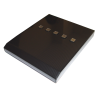
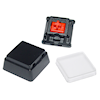
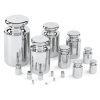
Works on any platform including iPads, Android tablets and phones.
1-5 button pressure sensitive force activated USB response pad key features
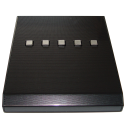
 A
wide variety of researchers could benefit by collecting force
data, or pressure sensitive data, in addition to more traditional
reaction time measures, e.g. neuroscientists, cognitive
psychologists, vision researchers etc.
A
wide variety of researchers could benefit by collecting force
data, or pressure sensitive data, in addition to more traditional
reaction time measures, e.g. neuroscientists, cognitive
psychologists, vision researchers etc.We appreciate that many may have used basic RT measures, but very few have currently used force data that tells them how hard a participant pressed a response button. This value-added data tells you much more than how hard a button was pressed however. For example, it can tell you if there was any preresponse activity, the impact of preresponse cuing, whether cues effect reaction times and force curves, the certainty or uncertainty behind the RT and more.
Simply plug into a USB port on your PC/Mac/Linux system and our pressure sensitive force activated USB response pad (PSURP) will appear as a second keyboard. Also works on any platform including Apple iPads, Android tablets and phones with appropriate adapter. Press a button and a standard keystroke will be sent to your experiment.
No need to recode! Works out of the box with E-Prime, SuperLab, Presentation, Inquisit, PsychoPy or any other software that can accept standard keyboard responses. Simply choose a force threshold and the key to be typed once that threshold is passed.
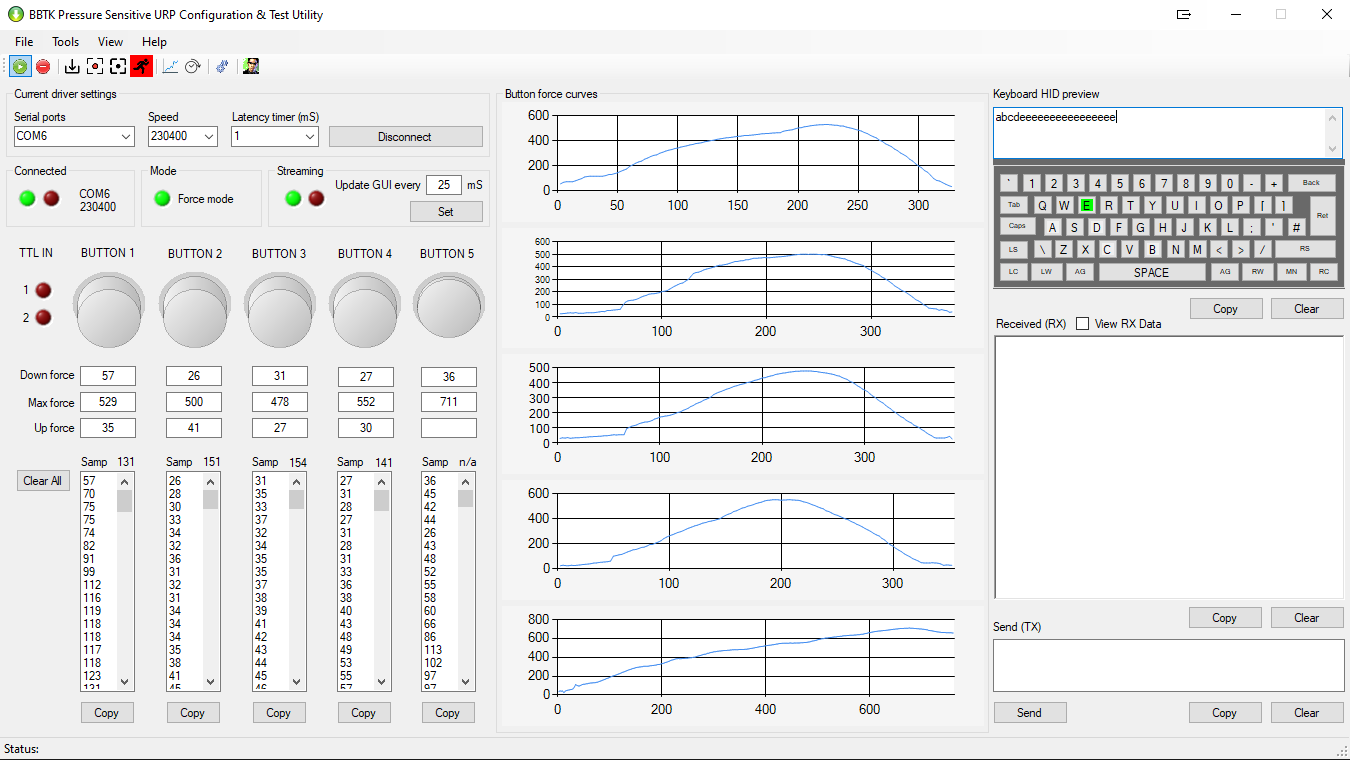
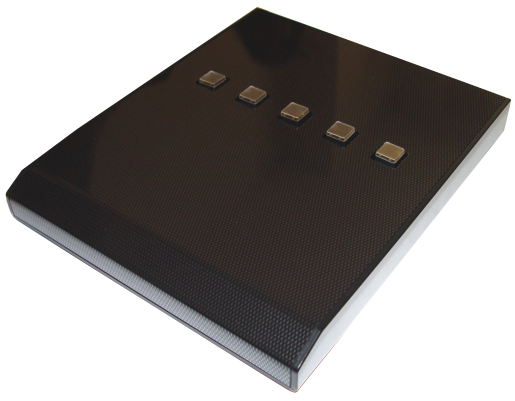 Our
partner App enables you to quickly and easily integrate pressure
sensitive measurements within your existing studies as it will
record force data and time lock it to the key presses recorded by
your experiment once it has finished. This means that you will
know exactly how hard someone pressed a button and for how long.
Our response pads aim is to let you add value to your experiments
by collecting pressure sensitive force data without having to
recode!
Our
partner App enables you to quickly and easily integrate pressure
sensitive measurements within your existing studies as it will
record force data and time lock it to the key presses recorded by
your experiment once it has finished. This means that you will
know exactly how hard someone pressed a button and for how long.
Our response pads aim is to let you add value to your experiments
by collecting pressure sensitive force data without having to
recode!If you want to go deeper you can choose to read the streamed serial pressure sensitive force data directly into your own experiment.
Finished in an attractive carbon fiber effect our response pad houses up to 5 pressure/force sensitive buttons with clear keycaps.
If you opt for a custom laser cut solution you are free to design your own button layout to make your response pad truly bespoke to you. What�s more you have the option to add an indicator light/LED which illuminates when a set pressure/force threshold is reached.
See a worked example showing how the PSURP could work for you.

*Remember although our pressure sensitive force activated USB response pad hardware is millisecond precise and helps reduce RT variability in your experiments it cannot automatically correct for any mistimings that are inherent within the experiment generator or other hardware you use.
For example, if your experiment generator presents an image and does not check for a response in a timely fashion, your OS intervenes, or an anti-virus check runs, your Response Times will remain inaccurate regardless of the quality of the response device. What | Why | How
For self-validation you should independently check the accuracy and consistency of your experiment generators presentation and response timing, or system as a whole, with a Black Box ToolKit v3 together with a BBTK pressure sensitive force activated USB response pad.
For sub-millisecond TTL event marking of stimuli and responses, you should combine our response pad with a mBBTK v2. The unique mBBTK v2 takes over all timing duties from any experiment generator so you can be 100% sure of your presentation, synchronization and response timings. Our pressure sensitive force activated USB response pad can accept 2x TTL input triggers from an mBBTK v2, e.g. from an Opto-detector or mic whilst button force presses can be sent as TTL event marks to the mBBTK.
Key features
|
|
Software suite for testing and configuring pressure sensitive force activated USB response pad
Our partner PC App allows you to test and configure the pressure sensitive force activated USB response pad with ease. Simply connect the USB leads and you can preview pressure force curves as well as the keyboard keystrokes that are sent to your experiment when a set force threshold is reached. The App also logs streamed force data so you can time lock and align that with your own RT's after your experiment has finished.

Choosing the thresholds at which key presses are sent to your experiment is easy using a simple configuration screen. Once configured settings are stored in non-volatile RAM on the response pad so that even when unplugged your settings are saved and the response pad is ready to go!
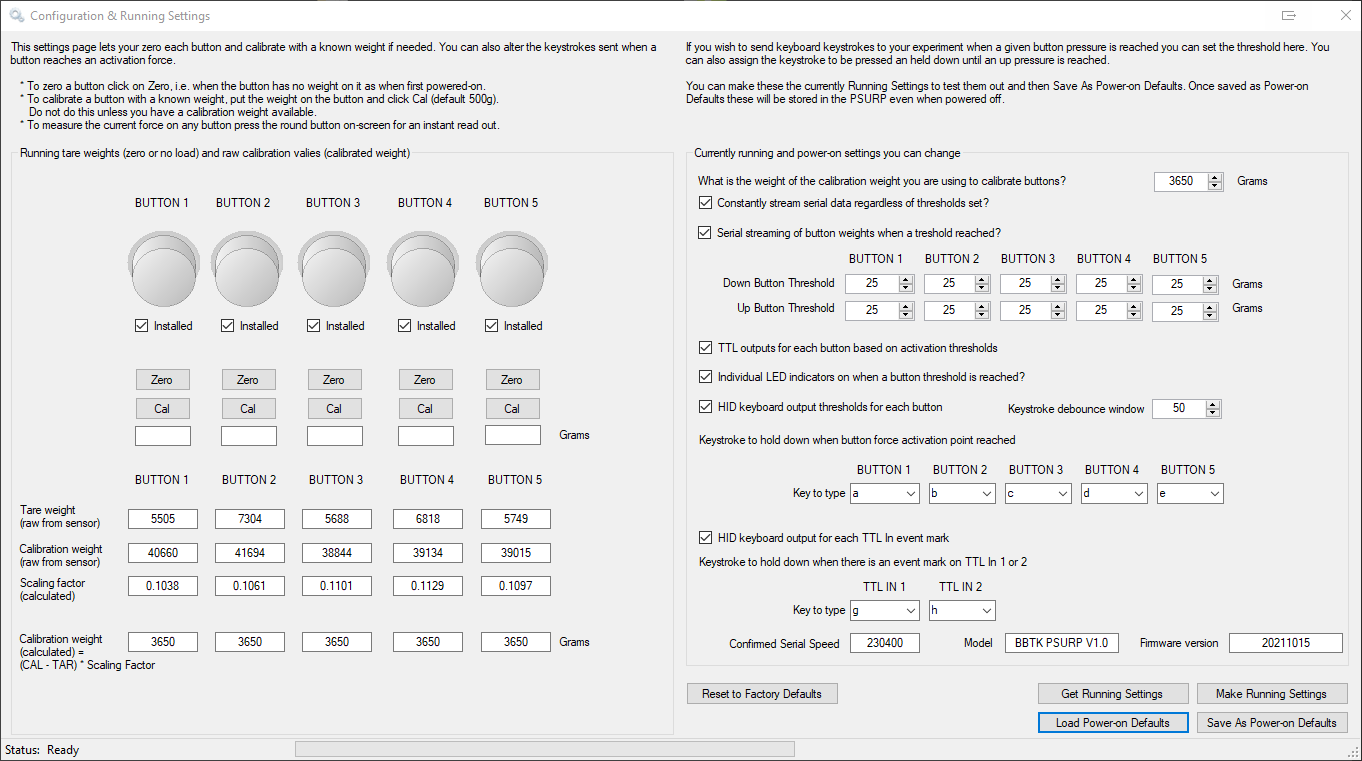
Data analysis and time locking your response data to pressure/force curves
Our software makes analysis of button presses and force curves straightforward even for novices. In this view individual button force curves are plotted from spreadsheet data that is laid out in a clear and concise way. Plots can be zoomed into, exported for reports and publications and each spreadsheet view can be exported to Excel or other spreadsheet software. You can even export data as TAB files for analysis in MATLAB etc.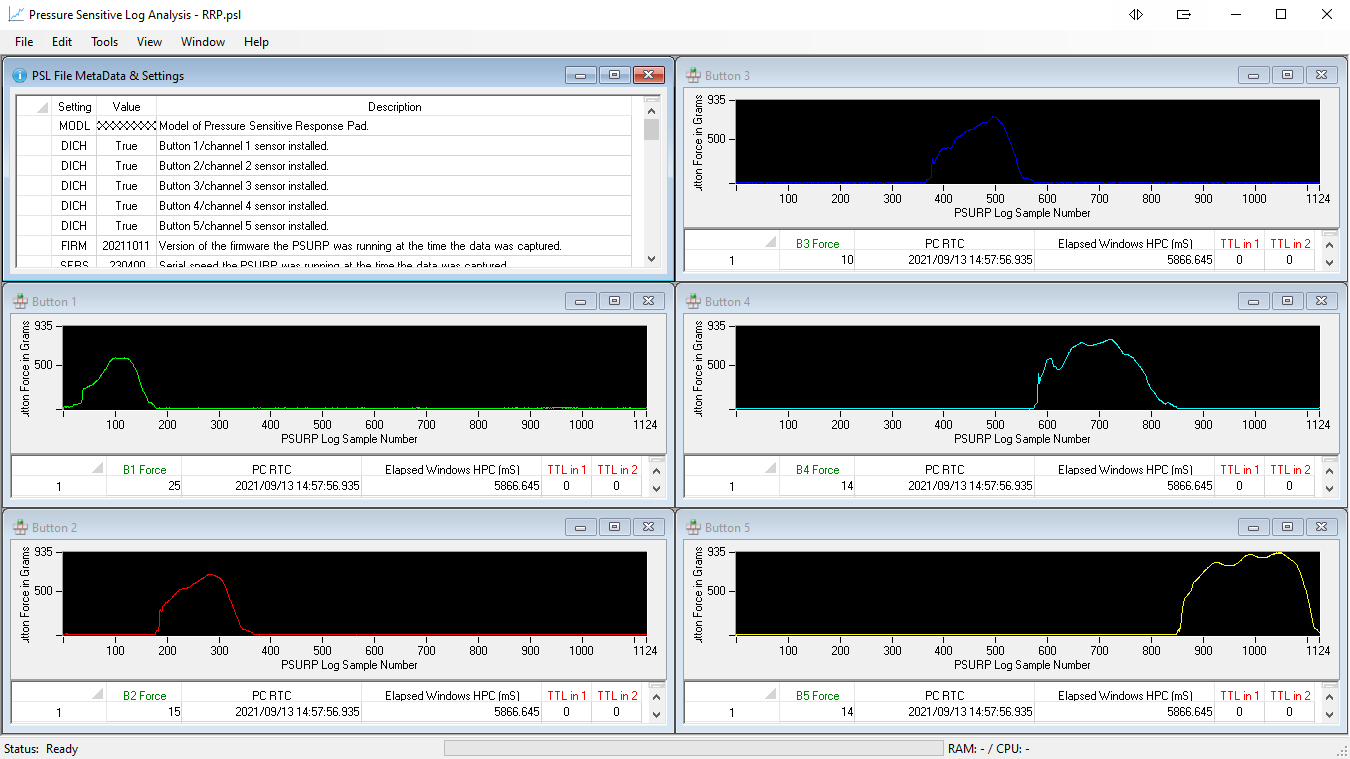
Time locking your experiments results to the force data that shows how hard each button was pressed is a breeze. Simply load the keyboard keypress data your experiment logged for each trial alongside the Pressure Sensitive Log (.PSL) file you recorded and the two can be time locked. This allows you to see each key press RT's alongside the pressure curves for each response.
In the example below, a PsychoPy file has been loaded and time locked against the Pressure Sensitive Log file recorded by the PSURP partner App. Below the first button press is shown locked with the RT and force data so you know how hard the button was pressed and for how long. We can see at which point the key press was sent to your experiment as it is automatically highlighted in the spreadsheet. Moveable cursors allow you to zoom in on the plot. Force data leading up to the keyboard keystroke is also shown along with the point where the key was flagged as up.
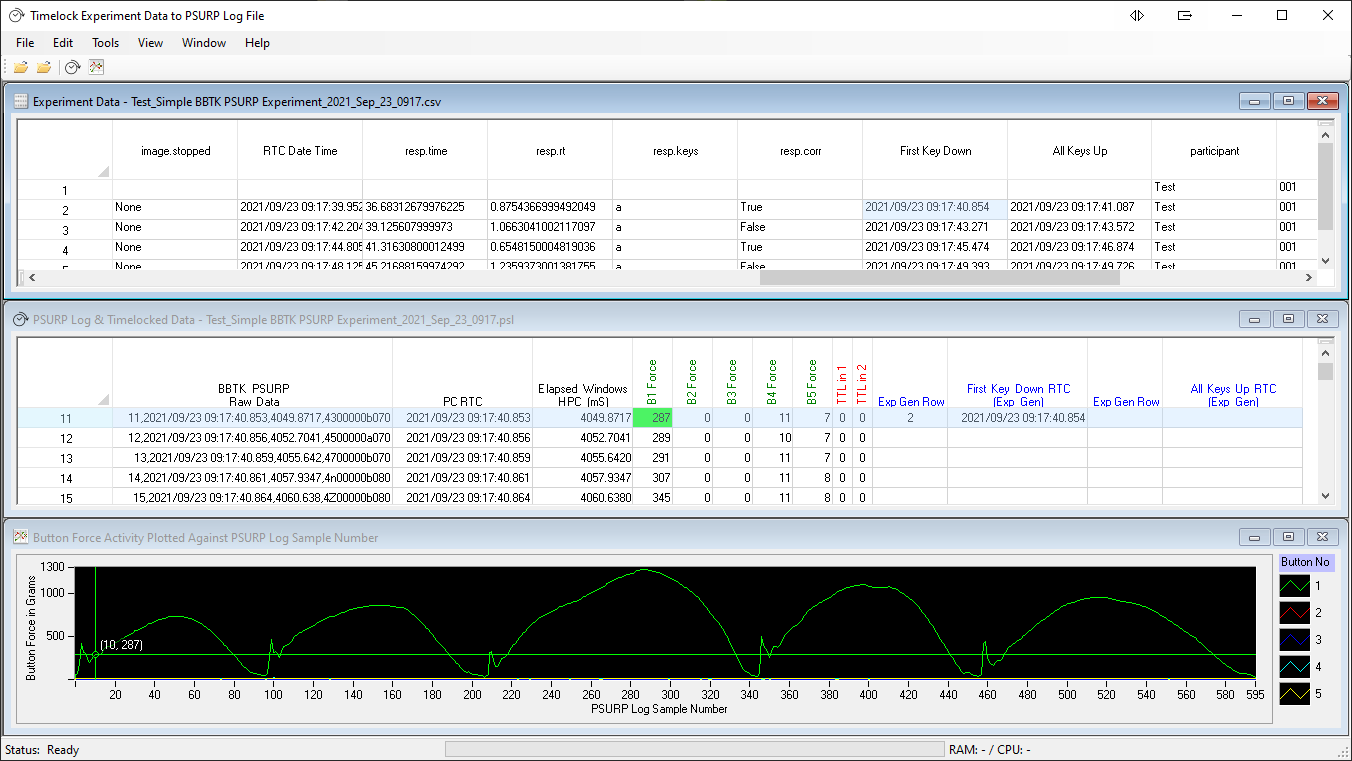
All data and plots in this view can be exported to Excel or TAB delimited files for further analysis in software such as MATLAB.
Custom laser cut layouts to your own design
 You
can customize your pressure/force sensitive button layout by
electing where to place between 1 to 5 buttons in a region
measuring 168.50 mm x 183.50 mm (L x W) shown in blue on the
schematics below.
You
can customize your pressure/force sensitive button layout by
electing where to place between 1 to 5 buttons in a region
measuring 168.50 mm x 183.50 mm (L x W) shown in blue on the
schematics below.You can also add indicator lights/LEDs per button which turn on when a set pressure/force threshold is reached and off when the force goes back below that threshold. These can be placed anywhere within the red area measuring 57 mm x 227.50 mm (L x W).
LED colors available:
| Red | Green | Yellow | Orange | Blue | White |
To help we have provided downloadable templates you can use with your favorite drawing package to customize your layout.
The examples below illustrate the corner extents of the area in which you can place your buttons (solid blue line) relative to the overall size of the pressure sensitive response pad. The round LED's show the corner extents of where you can place the indicator lights that show whether a button force threshold has been passed (solid red line).
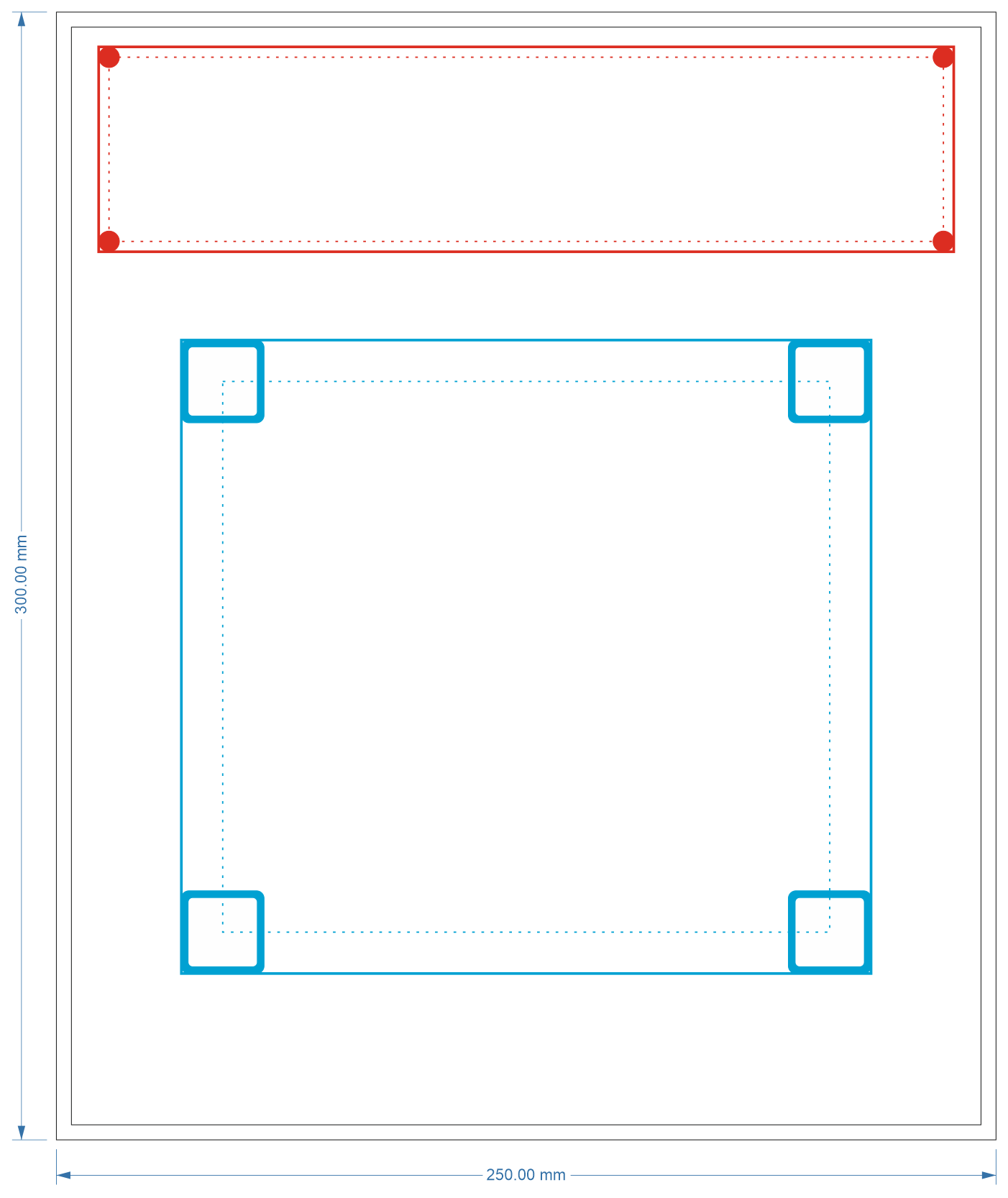 |
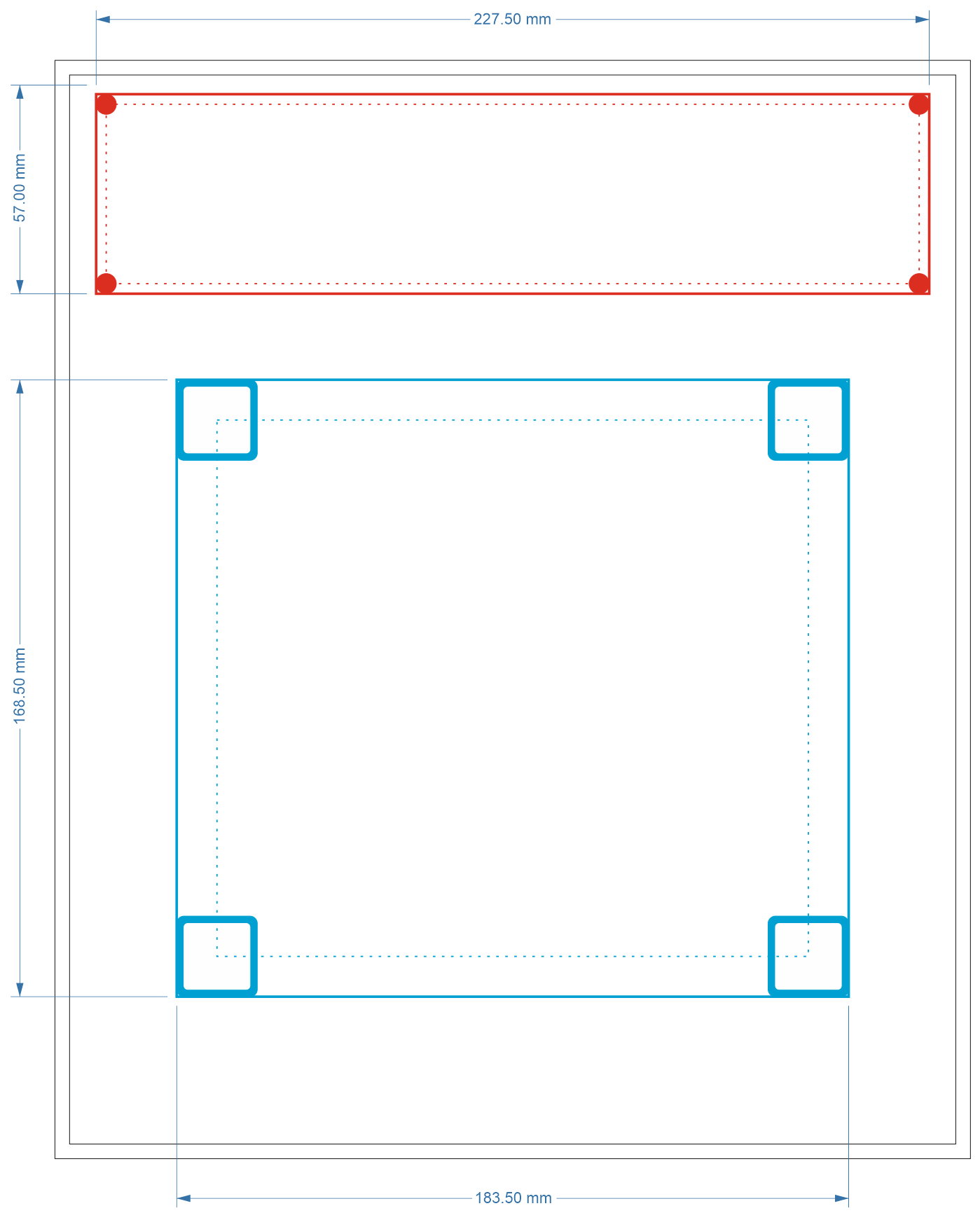 |
Download a template:
| CorelDRAW! 10 .CDR CorelDRAW! x7 .CDR |
AutoCAD .DWG AutoCAD .DXF |
Adobe Illustrator
.AI Adobe Acrobat .PDF |
Windows Meta File .WMF |
Send us your layout and we'll make it to your design. Alternatively give us a sketch and we'll send you a PDF proof of your design for approval. Nothing could be simpler!
Choice of linear button switch or isometric button
Each force sensor comes with your choice of standard Cherry MX linear button switch with tactile feedback (like a standard keyboard key) or Isometric non-moving button (like pushing your finger against a hard surface). But you can choose to have a spare replacement so you could swap between each type to determine which works best in your experiment.| Linear button switch | Isometric button |
||||
| |
|
To
help you decide which type of button might suit your
experiment best you should view the two videos opposite. |
|||
Rear connectors
| Connector | What does it do | How can I use it |
| Reset (push button) |
Changes mode or resets. | Short presses change mode, a long press resets the response pad or a very long press resets the pad to its factory default settings. |
| TTL (RJ45) |
A
dedicated TTL output line for each button that operates
with sub-millisecond precision for TTL event marking/TTL
triggers. Active high for the duration of each button
press once a preset threshold is met. Also has 2 bit TTL input port for event marking from other devices. |
Ideal
for +5V TTL event marking/TTL triggering of true
individual button response times or for time audit, e.g.
in EEG, connection to a BBTK etc. 5 bit port. Two input lines allow for injecting event marks/triggers into the serial pressure/force data streamed from the response pad along with keyboard keystroke output. For example a BBTK or mBBTK (event marking version) could event mark when an image appeared on your stim computer or sound was played. |
| Keyboard (USB 'B' square socket to PC 'A' flat) |
Connects to the PC you want to accept keyboard responses on. | Each button sends a standard key down response as might a normal keyboard if you pressed keys 1-5 for example. The key is held down once a preset force threshold is passed and released when less pressure is applied. |
| Serial (USB 'B' square socket to PC 'A' flat) |
Allows the response pad to stream serial force and event marking data at 230,400 bit/s to your stim PC. | Generally for ease of integration with your existing studies the PSURP streams data to our partner App to be time locked at a later date. This means you only need accept standard keyboard keystrokes. Using Serial this gives you the option to capture the raw streaming data in your own code/scripts. |
| Status LED | A tricolor LED indicates the mode the PSURP is running in. | The
LED provides a quick check on which mode you are in:
|
| Fault LED | Red fault LED. | This will be illuminated if you forget to set thresholds for keystrokes, if synch is lost with your stim PC or if pressures are detected when first connected. |
Technical specifications
|
|
*Remember although our USB response pads are millisecond precise and help reduce RT variability in your experiments they can't automatically correct for any mistimings that are inherent within the experiment generator you use. Hardware capable of sub-millisecond accuracy. Timing accuracy tied to PC or experiment generator used.
Unless otherwise labelled, all products offered for sale by The Black Box ToolKit Ltd are for academic study and/or research use only.

